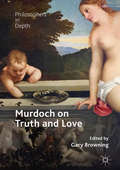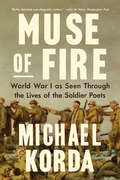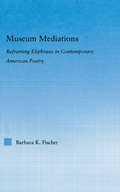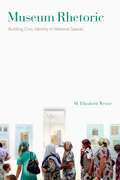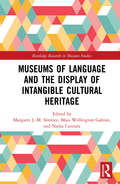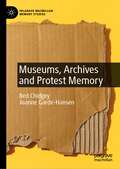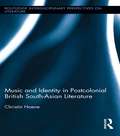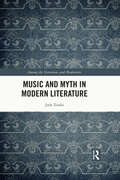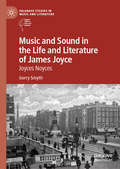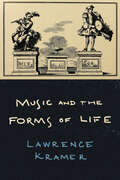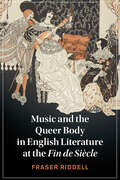- Table View
- List View
Murdoch on Truth and Love (Philosophers in Depth)
by Gary BrowningThis book reviews Iris Murdoch’s thought as a whole. It surveys the breadth of her thinking, taking account of her philosophical works, her novels and her letters. It shows how she explored many aspects of experience and brought together apparently contradictory concepts such as truth and love. The volume deals with her notions of truth, love, language, morality, politics and her life. It shows how she offers a challenging provocative way of seeing things which is related to but distinct from standard forms of analytical philosophy and Continental thought. Unlike so many philosophers she does offer a philosophy to live by and unlike many novelists she has reflected deeply on the kind of novels she aimed to write. The upshot is that her novels and her philosophy can be read together productively as contributions to how we can see others and the world.
Murnane
by Emmett StinsonGerald Murnane is one of Australia's most celebrated authors whose experimental and deeply idiosyncratic style has attracted rave reviews, including profiles in The New Yorker and The New York Times. Murnane's writing combines fiction with autobiography and returns obsessively to his particular and uncommon interests: horse-racing, marbles, stained glass, Catholic iconography, hermetic writers, and the Australian landscape. His fiction offers a window into what it means to be human, and how books and reading shape our self-understanding. Murnane examines the writer's recent work to explain both its significance to Australian literature and provide readers with a deeper understanding of his complex and self-referential fiction.
Muse of Fire: World War I as Seen Through the Lives of the Soldier Poets
by Michael KordaThe First World War comes to harrowing life through the intertwined lives of the soldier poets in Michael Korda’s epic Muse of Fire. Michael Korda, the best-selling author of Hero and Alone, tells the story of the First World War not in any conventional way but through the intertwined lives of the soldier poets who came to describe it best, and indeed to symbolize the war’s tragic arc and lethal fury. His epic narrative begins with Rupert Brooke, “the handsomest young man in England” and perhaps its most famous young poet in the halcyon days of the Edwardian Age, and ends five years later with Wilfred Owen, killed in action at twenty-five, only one week before the armistice. With bitter irony, Owen’s mother received the telegram informing her of his death on November 11, just as church bells tolled to celebrate the war’s end. Korda’s dramatic account, which includes anecdotes from his own family history, not only brings to life the soldier poets but paints an unforgettable picture of life and death in the trenches, and the sacrifice of an entire generation. His cast of characters includes the young American poet Alan Seeger, who was killed in action as a private in the French Foreign Legion; Isaac Rosenberg, whose parents had fled czarist anti-Semitic persecution and who was killed in action at the age of twenty-eight before his fame as a poet and a painter was recognized; Robert Graves and Siegfried Sassoon, whose friendship and friendly rivalry endured through long, complicated private lives; and, finally, Owen, whose fame came only posthumously and whose poetry remains some of the most savage and heartbreaking to emerge from the cataclysmic war. As Korda demonstrates, the poets of the First World War were soldiers, heroes, martyrs, victims, their lives and loves endlessly fascinating—that of Rupert Brooke alone reads like a novel, with his journey to Polynesia in pursuit of a life like Gauguin’s and some of his finest poetry written only a year before his tragic death. Muse of Fire is at once a portrait of their lives and a narrative of a civilization destroying itself, among the rubble, shadows, and the unresolved problems of which we still live, from the revival of brutal trench warfare in Ukraine and in the Middle East.
Museum Mediations: Reframing Ekphrasis in Contemporary American Poetry (Literary Criticism and Cultural Theory)
by Barbara K. FisherFirst published in 2006. Routledge is an imprint of Taylor & Francis, an informa company.
Museum Rhetoric: Building Civic Identity in National Spaces (RSA Series in Transdisciplinary Rhetoric #5)
by George Sand Gretchen Van SlykeSet in the French countryside of George Sand’s childhood and narrated in the unique voice of a Berrichon peasant, La Petite Fadette is a beloved 1848 novel about identical twin brothers and Fadette, the mysterious waif with whom they both fall in love. The brothers, Landry and Sylvinet, belong to a highly respected farm family. When young Landry meets Fadette, whose very name suggests that she is a witch, he is captivated by the girl despite her lowly status and disreputable family. Sylvinet soon follows suit. Fadette’s relationship with the twins defies the patriarchal norms of French society as well as the expectations of the village, resulting in a tale of love, courage, and clever strategy winning out over superstition and prejudice.Often regarded as a simple country tale, Sand’s novel is layered with meaning, including subtle nods to the burgeoning desire for political and sexual equality in nineteenth-century France. This thoughtful critical translation by Gretchen van Slyke brings the complexity of the original story to life. Her introduction explores the autobiographical and political dimensions of the novel, and her translation preserves the rustic charm and archaic flavor of Sand’s language.An invaluable contribution to French literary studies and nineteenth-century literature studies, this new edition ensures that La Petite Fadette will be read by generations to come.
Museum Rhetoric: Building Civic Identity in National Spaces (RSA Series in Transdisciplinary Rhetoric #5)
by M. Elizabeth WeiserIn today’s diverse societies, museums are the primary institutions within the public sphere in which individuals can both engage critical thought and celebrate community. This volume uses the lens of rhetoric to explore the role these societal repositories play in establishing and altering cultural heritage and national identity.Based on fieldwork conducted in over sixty museums in twenty-two countries across six continents, Museum Rhetoric explores how heritage museum exhibits persuade visitors to unite their own sense of identity with that of the broader civic society and how the latter changes in response. Elizabeth Weiser explores what compels communities, organizations, and nations to create museum spaces, and how museums operate as sites of both civic engagement and rhetorical persuasion. Moving beyond rhetorical explorations of museums as “memory sites,” she shows how they intentionally straddle the divides between style and content, intellect and affect, unity and diversity, and why their portrayal of the past matters to civic life—and particularly studies of nationalism—in the present and future.Deeply researched and artfully argued, Museum Rhetoric sheds light on the public impact of cultural and aesthetic heritage and opens avenues of inquiry for scholars of museum studies and public history.
Museum Texts: Comunication Frameworks (Museum Meanings)
by Louise RavelliAnswering key questions in the study of how museums communicate, Louise Ravelli provides a set of frameworks to investigate the complexities of communication in museums: * What is an appropriate level of complexity for a written label?* Why do some choice in language make a more direct relation to visitors?* Is there a correct way of presenting a particular view of content?* How do design practices contribute to the overall meanings being made? The frameworks enhance the way we critically analyze and understand museums text, both in the sense of conventional – written texts in museums – and in an expanded sense of the museum as a whole operating as a communicative text. Using a wide range of examples Ravelli argues that communication contributes fundamentally to what a museum is, who it relates to and what it stands for. Not only museum studies and communications studies students, but also professionals in the field will find Museum Texts an indispensable guide on communication frameworks.
Museum Trouble
by Ruth HobermanBy 1901, the public museum was firmly established as an important national institution in British life. Its very centrality led to its involvement in a wide range of debates about art, knowledge, national identity, and individual agency. Ruth Hoberman argues that these debates concerned writers as well. Museum Trouble focuses on fiction written between 1890 and 1914 and the ways in which it engaged the issues dramatized by and within the museum.Those issues were many. Art critics argued about what kind of art to buy on behalf of the nation, how to display it, and whether salaried professionals or aristocratic amateurs should be in charge. Museum administrators argued about the best way to exhibit scientific and cultural artifacts to educate the masses while serving the needs of researchers. And novelists had their own concerns about an increasingly commercialized literary marketplace, the nature of aesthetic response, the impact of evolution and scientific materialism, and the relation of the individual to Britain's national and imperial identity.In placing the many crucial museum scenes of Edwardian fiction in the context of late nineteenth-century and early twentieth-century cultural discourse, Museum Trouble shows how this turn-of-the-century literature anticipated many of the concerns of the modernist writers who followed.
Museums as Sites of Transformative Foreign Language Learning Beyond the Classroom (New Language Learning and Teaching Environments)
by Fabiana FazziThis book takes a look at the affordances of engaging second/foreign language students in educational projects that bridge the gap between the classroom and the museum. Studies on language learning and teaching beyond the classroom have shown that students learn in different settings and through different types of activities and that their learning is influenced by the intersection of different dimensions. Drawing on both language and museum learning and teaching research, this book discusses the aspects that make the museum an ideal language learning setting and then outlines evidence-based pedagogical guidelines to design effective learning experiences for language learners across the classroom and the museum. It will be of interest to graduate students, language teachers, teacher trainers, museum educators, and researchers in fields including Educational Linguistics, Anthropological Linguistics, and Museum Studies (Education).
Museums of Language and the Display of Intangible Cultural Heritage (Routledge Research in Museum Studies)
by Maia Wellington Gahtan Margaret J.-M. Sönmez Nadia CannataMuseums of Language and the Display of Intangible Cultural Heritage presents essays by practitioners based in language museums around the world. Describing their history, mission, and modes of display, contributors demonstrate the important role intangible heritage can and should play in the museum. Arguing that languages are among our most precious forms of cultural heritage, the book also demonstrates that they are at risk of neglect, and of endangerment from globalisation and linguistic imperialism. Including case studies from across Europe, North America, Africa, and Asia, this book documents the vital work being done by museums to help preserve languages and make them objects of broad public interest. Divided into three sections, contributions to the book focus on one of three types of museums: museums of individual languages, museums of language groups – both geographic and structural – and museums of writing. The volume presents practical information alongside theoretical discussions and state-of-the-art commentaries concerning the representation of languages and their cultural nature. Museums of Language and the Display of Intangible Cultural Heritage is the first volume to address the subject of language museums and, as such, should be of interest to academics, researchers, and postgraduate students in the fields of museum and cultural heritage studies, applied linguistics, anthropology, tourism, and public education.
Museums, Archives and Protest Memory (Palgrave Macmillan Memory Studies)
by Joanne Garde-Hansen Red ChidgeyThis book addresses the emergence of ‘protest memory’ as a powerful contemporary shaper of ideas and practices in culture, media and heritage domains. Directly focused on the role of museum and archive practitioners in protest memory curation, it makes a compelling contribution to our understanding of how social movements and activist experiences are publicly remembered and activated for social and environmental justice.
Mushroom Clouds: Ecocritical Approaches to Militarization and the Environment in East Asia (Routledge Studies in World Literatures and the Environment)
by Simon C. Estok, Iping Liang, and Shinji IwamasaMushroom Clouds: Ecocritical Approaches to Militarization and the Environment in East Asia examines the growing significance of the eco-implications of the increasing militarism of East Asia. As a transcultural image and metaphor, mushroom clouds signify anthropogenic violence and destruction, as exemplified by wars and nuclear bombings. Immediately evoking memories of Hiroshima and Nagasaki, the mushroom clouds metaphor has deep roots and implications in East Asia, and this volume explores these roots and implications from the perspectives of a variety of scholars and artists from different parts of East Asia. The chapters that comprise Mushroom Clouds respond to the increasingly dangerous developments in the world that led up to and have occurred since the 2016 presidential election of Donald Trump, developments that threaten the stability of the region and the world. In the wake of the 70th anniversary of the division of Korea, increasing attention has been focused on the legacy of the Cold War, on the one hand, and on the continuing militarization of East Asia, on the other. After the nuclear bombings in Hiroshima and Nagasaki, after the truce across the 38th parallel, after the shelling of Kinmen and Matsu, East Asia became (and remains) one of the most densely militarized regions in the world. Under the shadow of war, however, the concern about environmental impacts has been growing, not only in social discourse but also in literature and the visual arts. The first of its kind, Mushroom Clouds gathers ecocritics from East Asia to examine issues such as militarization, militarized islands, military tourism, military villages, post-war environments, nuclear accidents, and the demilitarized sone (DMZ) wildlife, among others, in East Asia.
Music Is My Life: Louis Armstrong, Autobiography, and American Jazz
by Daniel SteinMusic Is My Lifeis the first comprehensive analysis of Louis Armstrong's autobiographical writings (including his books, essays, and letters) and their relation to his musical and visual performances. Combining approaches from autobiography theory, literary criticism, intermedia studies, cultural history, and musicology, Daniel Stein reconstructs Armstrong's performances of his life story across various media and for different audiences, complicating the monolithic and hagiographic views of the musician. The book will appeal to academic readers with an interest in African American studies, jazz studies, musicology, and popular culture, as well as general readers interested in Armstrong's life and music, jazz, and twentieth-century entertainment. While not a biography, it provides a key to understanding Armstrong's oeuvre as well as his complicated place in American history and twentieth-century media culture.
Music Management, Marketing and PR
by Chris Anderton James Hannam Johnny HopkinsThis book is your guide to the study and practice of music management and the fast-moving music business of the 21st century. Covering a range of careers, organisations, and practices, this expert introduction will help aspiring artists, managers, and executives to understand and succeed in this exciting sector. Featuring exclusive interviews with industry experts and discussions of well-known artists, it covers key areas such as artist development, the live music sector, fan engagement, and copyright. Other topics include: Managing contracts and assembling teams. Using data audits of platforms to adapt campaigns. Shaping opinions about music, musicians, events. How the music industry can be more diverse, inclusive, and equitable for the benefit of all. Working with venues, promoters, booking agents, and tour managers. Branding, sponsorship, and endorsement. Funding, crowdsourcing and royalty collection. Ongoing digital developments such as streaming income and algorithmic recommendation. Balancing the creative and the commercial, it is essential reading for students of music management, music business, and music promotion – and anybody looking to build their career in the music industries. Dr Chris Anderton, Johnny Hopkins, and James Hannam all teach on the BA Music Business at the Faculty of Business, Law and Digital Technologies at Solent University, Southampton, UK.
Music Management, Marketing and PR
by Chris Anderton James Hannam Johnny HopkinsThis book is your guide to the study and practice of music management and the fast-moving music business of the 21st century. Covering a range of careers, organisations, and practices, this expert introduction will help aspiring artists, managers, and executives to understand and succeed in this exciting sector. Featuring exclusive interviews with industry experts and discussions of well-known artists, it covers key areas such as artist development, the live music sector, fan engagement, and copyright. Other topics include: Managing contracts and assembling teams. Using data audits of platforms to adapt campaigns. Shaping opinions about music, musicians, events. How the music industry can be more diverse, inclusive, and equitable for the benefit of all. Working with venues, promoters, booking agents, and tour managers. Branding, sponsorship, and endorsement. Funding, crowdsourcing and royalty collection. Ongoing digital developments such as streaming income and algorithmic recommendation. Balancing the creative and the commercial, it is essential reading for students of music management, music business, and music promotion – and anybody looking to build their career in the music industries. Dr Chris Anderton, Johnny Hopkins, and James Hannam all teach on the BA Music Business at the Faculty of Business, Law and Digital Technologies at Solent University, Southampton, UK.
Music and Gender in English Renaissance Drama (Routledge Advances in Theatre & Performance Studies)
by Katrine K. WongThis book offers a survey of how female and male characters in English Renaissance theatre participated and interacted in musical activities, both inside and outside the contemporary societal decorum. Wong’s analysis broadens our understanding of the general theatrical representation of music, or musical dramaturgy, and complicates the current discussion of musical portrayal and construction of gender during this period. Wong discusses dramaturgical meanings of music and its association with gender, love, and erotomania in Renaissance plays. The negotiation between the dichotomous qualities of the heavenly and the demonic finds extensive application in recent studies of music in early modern English plays. However, while ideological dualities identified in music in traditional Renaissance thinking may seem unequivocal, various musical representations of characters and situations in early modern drama would prove otherwise. Wong, building upon the conventional model of binarism, explores how playwrights created their musical characters and scenarios according to the received cultural use and perception of music, and, at the same time, experimented with the multivalent meanings and significance embodied in theatrical music.
Music and Identity in Postcolonial British South-Asian Literature (Routledge Interdisciplinary Perspectives on Literature)
by Christin HoeneThis book examines the role of music in British-South Asian postcolonial literature, asking how music relates to the construction of postcolonial identity. It focuses on novels that explore the postcolonial condition in India, Pakistan, and the United Kingdom: Vikram Seth's A Suitable Boy, Amit Chaudhuri's Afternoon Raag, Suhayl Saadi's Psychoraag, Hanif Kureishi's The Buddha of Suburbia and The Black Album, and Salman Rushdie's The Ground Beneath Her Feet, with reference to other texts, such as E.M. Forster's A Passage to India and Vikram Seth's An Equal Music. The analyzed novels feature different kinds of music, from Indian classical to non-classical traditions, and from Western classical music to pop music and rock 'n' roll. Music is depicted as a cultural artifact and as a purely aestheticized art form at the same time. As a cultural artifact, music derives meaning from its socio-cultural context of production and serves as a frame of reference to explore postcolonial identities on their own terms. As purely aesthetic art, music escapes its contextual meaning. The transgressive qualities of music render it capable of expressing identities irrespective of origin and politics of location. Thereby, music in the novels marks a very productive space to imagine the postcolonial nation and to rewrite imperial history, to express the cultural hybridity of characters in-between nations, to analyze the state of the nation and life in the multicultural diaspora of contemporary Great Britain, and to explore the ramifications of cultural globalization versus cultural imperialism. It will be a useful research and teaching tool for those interested in postcolonial literature, music studies, cultural studies, contemporary literature and South-Asian literature.
Music and Identity in Twentieth-Century Literature from Our America
by Marco Katz MontielIntellectual discussions have fallen short of developing a truly hemispheric view of the Americas thus far. With eye towards filling this gap, Music and Identity in Twentieth-Century Literature from Our America, written by a professional musician turned literary scholar, offers a one-of-a-kind approach to exploring American homologies while taking account of national and regional differences. Based on an interdisciplinary Cultural Studies approach, this new methodology brings rigorous musicianship and critical literary theory to consider relationships between musical protagonists from Colombia, Cuba, and the United States in novels by Gabriel Garcia Marquez, Alejo Carpentier, Zora Neale Hurston, and John Okada. In addition to providing useful ideas for inter-American studies, this book opens up new ways of reading texts related to Latin American, African American, and Asian American studies. "
Music and Myth in Modern Literature (Among the Victorians and Modernists)
by Josh TorabiThis book is the first major study that explores the intrinsic connection between music and myth, as Nietzsche conceived of it in The Birth of Tragedy (1872), in three great works of modern literature: Romain Rolland’s Nobel Prize winning novel Jean-Christophe (1904-12), James Joyce’s modernist epic Ulysses (1922), and Thomas Mann’s late masterpiece Doctor Faustus (1947). Juxtaposing Nietzsche’s conception of the Apollonian and Dionysian with narrative depictions of music and myth, Josh Torabi challenges the common view that the latter half of The Birth of Tragedy is of secondary importance to the first. Informed by a deep knowledge of Nietzsche’s early aesthetics, the book goes on to offer a fresh and original perspective on Ulysses and Doctor Faustus, two world-famous novels that are rarely discussed together, and makes the case for the significance of Jean-Christophe, which has been unfairly neglected in the Anglophone world, despite Rolland’s status as a major figure in twentieth-century intellectual and literary history. This unique study reveals new depths to the work of our most enduring writers and thinkers.
Music and Poetry in a Colombian Village: A Tri-Cultural Heritage
by George ListThe history and an analysis of the folk music and poetry from the small village in Colombia.
Music and Sound in the Life and Literature of James Joyce: Joyces Noyces (Palgrave Studies in Music and Literature)
by Gerry SmythMusic and Sound in the Life and Literature of James Joyce: Joyces Noyces offers a fresh perspective on the Irish writer James Joyce’s much-noted obsession with music. This book provides an overview of a century-old critical tradition focused on Joyce and music, as well as six in-depth case studies which revisit material from the writer’s career in the light of new and emerging theories. Considering both Irish cultural history and the European art music tradition, the book combines approaches from cultural musicology, critical theory, sound studies and Irish studies. Chapters explore Joyce’s use of repetition, his response to literary Wagnerism, the role and status of music in the aesthetic and political debates of the fin de siècle, music and cultural nationalism, ubiquitous urban sound and ‘shanty aesthetics’. Gerry Smyth revitalizes Joyce’s work in relation to the ‘noisy’ world in which the author wrote (and his audience read) his work.
Music and Translation: New Mediations in the Digital Age (Palgrave Studies in Translating and Interpreting)
by Lucile DesblacheThis book explores how transformations and translations shape musical meanings, developments and the perception of music across cultures. Starting with the concept of music as multimodal text, the author understands translation as the process of transferring a text from one language – verbal or not – into another, interlingually, intralingually or intersemiotically, as well as the products that are derived from this process. She situates music and translation within their contemporary global context, examining the tensions between local and global, cosmopolitan and national, and universal and specific settings, to arrive at a celebration of the translational power of music and an in-depth study of how musical texts are translated. This book will be of interest to translation studies scholars who want to broaden their horizons, as well as to musicians and music scholars seeking to understand how cultural exchange and dissemination can be driven by translation.
Music and the Environment in Dystopian Narrative: Sounding The Disaster (Palgrave Studies In Music And Literature Ser.)
by Heidi HartMusic and the Environment in Dystopian Narrative: Sounding the Disaster investigates the active role of music in film and fiction portraying climate crisis. From contemporary science fiction and environmental film to “Anthropocene opera,” the most arresting eco-narratives draw less on background music than on the power of sound to move fictional action and those who receive it. Beginning with a reflection on a Mozart recording on the 1970s’ Voyager Golden Record, this book explores links between music and violence in Lidia Yuknavitch’s 2017 novel The Book of Joan, songless speech in the opera Persephone in the Late Anthropocene, interrupted lyricism in the eco-documentary Expedition to the End of the World, and dread-inducing hurricane music in the Brecht-Weill opera Rise and Fall of the City of Mahagonny. In all of these works, music allows for a state of critical vulnerability in its hearers, communicating planetary crisis in an embodied way.
Music and the Forms of Life
by Lawrence KramerInventors in the age of the Enlightenment created lifelike androids capable of playing music on real instruments. Music and the Forms of Life examines the link between such simulated life and music, which began in the era's scientific literature and extended into a series of famous musical works by Haydn, Mozart, and Beethoven. Music invented auditory metaphors for the scientific elements of life (drive, pulse, sensibility, irritability, even metabolism), investigated the affinities and antagonisms between life and mechanism, and explored questions of whether and how mechanisms can come to life. The resulting changes in the conceptions of both life and music had wide cultural resonance at the time, and those concepts continued to evolve long after. A critical part of that evolution was a nineteenth-century shift in focus from moving androids to the projection of life in motion, culminating in the invention of cinema. Weaving together cultural and musical practices, Lawrence Kramer traces these developments through a collection of case studies ranging from classical symphonies to modernist projections of waltzing specters by Mahler and Ravel to a novel linking Bach's Goldberg Variations to the genetic code.
Music and the Queer Body in English Literature at the Fin de Siècle (Cambridge Studies in Nineteenth-Century Literature and Culture #137)
by Fraser RiddellDrawing on an ambitious range of interdisciplinary material, including literature, musical treatises and theoretical texts, Music and the Queer Body explores the central place music held for emergent queer identities in the late-nineteenth and early-twentieth centuries. Canonical writers such as Walter Pater, E. M. Forster and Virginia Woolf are discussed alongside lesser-known figures such as John Addington Symonds, Vernon Lee and Arthur Symons. Engaging with a number of historical case studies, Fraser Riddell pays particular attention to the significance of embodiment in queer musical subcultures and draws on contemporary queer theory and phenomenology to show how writers associate music with shameful, masochistic and anti-humanist subject positions. Ultimately, this study reveals how literary texts at the fin de siècle invest music with queer agency: to challenge or refuse essentialist identities, to facilitate re-conceptions of embodied subjectivity, and to present alternative sensory experiences of space and time. This title is also available as Open Access on Cambridge Core.
